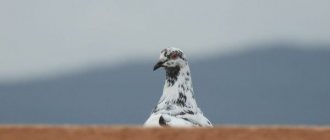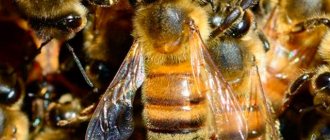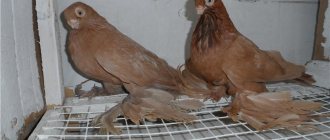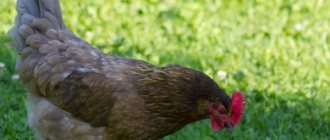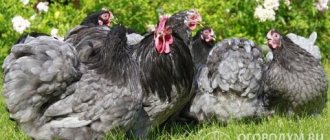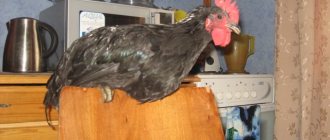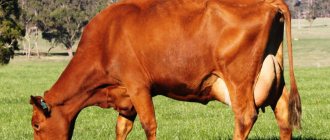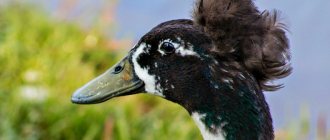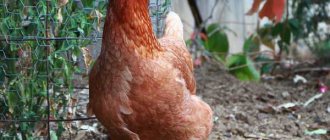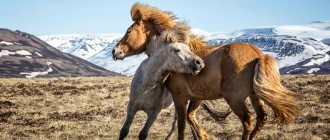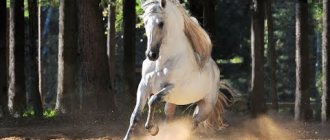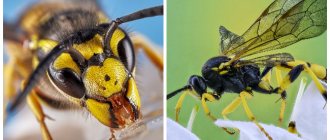4 minutes to read the article
PhotoVideoComments
Almost all pigeon breeders dream of having such a breed as the “Poutysh” pigeon in their live collection. These pigeons have a rather memorable and bright appearance. By nature, these birds are not aggressive; their calm and cautious disposition makes them easily vulnerable.
Every self-respecting bird breeder wants to have a pigeon of the “Poutysh” breed in his collection.
Some experts do not recommend housing pouters with other types of pigeons; quite often there have been cases of injury to the crop of these pigeons. After all, the main feature of this breed is precisely the ability to inflate its crop to such a size that sometimes even the beak is not visible behind it. This breed was developed in Belgium and Holland. Today the most common and popular varieties of puffers are:
- Great English.
- Brno.
- Saddle Czech.
- Pomeranian.
In general, all these bird species are very similar, but at the same time they have their own standards and specific differences. What all these birds have in common is the difficulty of breeding and caring for them. Pouting pigeons are very demanding to keep; they require a lot of attention and care from their breeder. In order to maintain the purity of the species, it is necessary to carry out a careful and strict selection of chicks, which is not so easy, because these pigeons are not fertile and have weak genetics. For example, breeding a line with a certain color of feathers on the head may take too much time, often taking more than 1 year.
Each species has its own standards and require strict guidelines; culling in the breed occurs quite often. In this breed, it is unacceptable for the bird to have legs that are too short or too closely set, as well as a short body or a crop that is inseparable from the torso. For selective breeding of this breed, it is necessary to carefully and strictly select young animals to maintain a pure breed.
Origin story
What the breed looks like, photo:
Most poultry farmers consider Western Europe to be the homeland of poultry birds: the Netherlands or Belgium. In the 16th century, this variety was on a wave of popularity in these countries.
However, the history of the ancient breed is controversial. Written evidence dating back to 1345 mentions Spanish pigeons inflating crops.
It is this feature that distinguishes pouters from other breeds of pigeons. There is an assumption that it was from Spain, which in the 16th century was under the rule of the Habsburg dynasty, that the blowers came to Europe.
For several centuries, pouts were bred and crossed with other species; after selection work, more than 20 varieties of the breed appeared. But today poultry farmers do not stop there and continue to breed new subspecies of these pigeons.
Since breeding is carried out in many countries and regions, the most popular varieties of this breed come from different places in Europe: England, Norway, Hungary, Germany, the Czech Republic, etc.
Content
The pout is an aviary bird, and some dwarf species can even be kept in your home. It is necessary to take into account the temperament of some fighting males and house them separately from other individuals.
Since these pigeons do not have sufficient immunity, both chicks and adults should be protected from drafts, sudden temperature changes, frost and high humidity. Clean and dry bedding is the key to bird health. Regular cleaning of the premises, washing of drinking bowls, feeders and baths, as well as disinfection of the enclosure twice a year are required.
Breeding pigeons for meat as a business. Nuances of the organization and real income figures
Article
Breeding pigeons at home for beginners. How to gain experience
More details
Birds of prey that pigeons are afraid of. Reminder for pigeon breeder
Article
Basic information that a poultry farmer needs to know about the physiology of pigeons
Read
Rules for keeping pigeons: what should be in the dovecote and how to organize the feeding regime
More details
Artificial incubation of pigeon eggs: what are the features of the process and what to do after the chicks hatch
Read
Description
Some types of pouters are strikingly different from their counterparts - in appearance, height, color, presence or absence of such elements as shaggy legs, etc.
Each variety has its own strict standards; pigeons are often rejected. But the puffers still have general characteristics.
These include:
- An amazing ability to inflate its air sac to an incredible size: even its beak is lost behind it.
- The neck is spherical, turning into a crop. Tapers at the chest.
- Average build. Breast with fluff. An elongated large body, the location of which is almost vertical.
- A long tail.
- The head is round, small with a high forehead.
- Narrow wings. When they lie on the tail, they do not cross.
- Legs in “pants” (not in all individuals).
- The color of the plumage varies from pure white or black to colored, silver, and gray.
Only blowers that meet international standards are invited to exhibitions.
Diseases
Due to their rather weak immunity, puffers are prone to the following diseases:
- smallpox - red spots at the base of the beak, ears, near the nasal openings. There are wart rashes, swelling of the eyelids, lacrimation;
- ornithosis – lacrimation and pus from the eyes, loss of feathers, shortness of breath;
- coccidiosis - diarrhea, apathy, loss of weight, loss of appetite, sitting with the head retracted, loss of luster of plumage.
- Parasites
- Infectious
Trichomoniasis
Main symptoms, measures for treatment and prevention of the disease
Read
Worms
What is the danger of infection, how to treat and prevent it
Read
Paratyphoid
A disease that leads to pathological changes in the gastrointestinal tract and the development of septicemia.
Read
Psittacosis
Disease with severe respiratory disorders
Read
Coccidiosis
An infectious disease that affects the tissues of the gastrointestinal tract
Read
Smallpox
Infectious disease of pigeons. Affects the skin, mucous membranes and leads to the death of the bird
Read
Salmonellosis
Characterized by indigestion, fatal to birds
Read
Kinds
To breed birds, you can choose from two dozen varieties of this breed, one or more - as desired. It is possible to keep pouters together, but it is problematic with other pigeon representatives.
Saddle Czech
A pigeon from Moravia, namely the city of Brno. This is one of the oldest breeds in Czechoslovakia. The birds are rather large (up to 45 cm long) with a medium-sized head that does not have a crest. The body is harmonious, and the tail continues the back, the chest and shoulders are wide.
The wings are of medium length, as expected, close together and lie on the body. In the rear third of the body there are legs, long - 15-17 cm - densely feathered. The Saddleback Pigeon's eyes are black or some other dark shade, but are sometimes tinged with red. Eyelids flesh-colored or red.
The goiter is large and wide, resembling a pear. The beak is strong, wedge-shaped and slightly curved at the end. A small light cere fits tightly to it.
The color of the beak matches the color of the plumage, which is two-colored. It can be yellow, black, gray or red. At the same time, other parts of the body remain white, for example, the stomach, paws, wings, etc. There is a colored stripe on the head that covers the crown and forehead. This is the main characteristic of the saddle-backed pigeon.
Brno
These pigeons also come from the Czech Republic - Brno and Prague, but are not similar in size to their predecessors.
The dwarf variety of pouters has a body length of only 32-35 cm (males and females). The bird's stance is straight, but the tail does not touch the ground. The wings cross, and if the back is narrow, they lag behind the body.
The legs are long. The figure is slim. When the Brno pigeon straightens up, it seems that its body below the crop is tied with a belt. The goiter itself is of the correct spherical shape.
The color of this species of birds is distinguished by a wide variety of patterns. Among the Brno breeds there are single-colored and belted individuals, storks and speckled ones.
Belts of pouters come in white and black, and one color (it is always very bright) is found in individuals of the following colors:
- yellow;
- red;
- black;
- pale yellow;
- blue;
- silver, etc.
Pigeons are interesting for their temperament and elegant constitution. The cooing of the Brno puffers is not as deep and loud as that of its relatives. The voice sounds higher.
When a male is courting a female, he does not just coo, but jumps, stepping only on her toes. At the same time, it does not bend at an angle of 45°, but maintains a vertical position of the body. This species flies well, so the birds can be trained.
Pomeranian
Pomeranians were bred in the 19th century in Vorpommern on the island of Rügen in the Baltic Sea. The breeders took birds from Holland, England and Belgium as a basis.
In 1869, the variety received its official name. The Pomeranian is a powerful, large representative of the breed (reaches 50-52 cm). His body is slender, his posture is beautiful, his head is without tufts. The wings are adjacent to the body.
The tail is a little full. The legs have shaggy feathers with long (up to 14 cm) feathers. The goiter is huge, pear-shaped. The peculiarity of the species is the throwing back of the head when the crop is inflated.
The beak of Pomeranian pouters is small, similar in color to the plumage: beige in light ones, dark brown in others. Eye color also depends on the color of the bird.
The following types of plumage are common:
- pure white without adding other shades;
- white with a colored tail, such as gray and black;
- colored - red, black, yellow, gray, having dark belts on the shields or a white heart on the crop;
- multi-colored with white legs, tail, belly and wing tips.
Great English
A purebred representative of the species. Like Pomeranian pigeons, these pigeons are large representatives of pouters. Breeders bred them in the 17th century from Dutch and Roman breeds.
They had a huge impact on pigeon breeding, being used to breed other varieties of pigeons and improve pouters.
The exterior of the British is as follows:
- Individuals grow up to 40-50 cm in length.
- They have an oval smooth head and a slightly convex forehead.
- Almost vertical stance with an elastic, well-developed crop.
- Next to the strong beak is a small wax, the color of which is the color of the plumage and seems to be powdered.
- The waist is thin, with a vest (that's what its front part is called).
- The back is in line with the tail. A clear depression between the shoulders.
- The wings are tightly closed and lie flat on the tail, which is rounded at the end.
- The legs are set close together, their length is about 18 cm from the hip to the middle toe. The feathering on the legs is short, the feathers on the toes form a so-called “plate”.
The plumage of English pouters ranges from white to black (e.g., reddish, yellow, glaucous, silver). There are birds without patterns - that is, pure white without impurities. Colored individuals have a white belly, flight feathers, and chest (crescent).
And on the wing shields there are “epaulets” made of small feathers, which can number from 5 to 12. Birds are valued all over the world for their beautiful appearance. Despite their large size, pigeons are active and love to rise and soar in the sky.
Dwarf
Some varieties of pouters are classified as dwarf. But this dwarfism is only in comparison with other, larger representatives of the breed.
For example, English dwarfs reach a length of 32-34 cm versus 50 cm (the average size of English ones). Brno dogs are also considered miniature. Both of these varieties have long legs. And the puffers bred in Amsterdam are the Amsterdam (Dutch) spherical ones - short-legged.
Typically, the characteristic “dwarf” refers to English pouters. For the first time, miniature individuals became known in the 80s of the 19th century; they were the result of crossing Brno and English pigeons.
Outwardly, they completely repeat the British ancestor, the only differences are in size. The peculiarity of the breed is that it is kept entirely in an aviary; these birds are extremely thermophilic. You can even start them in an apartment.
Short-legged Dutch birds are popular in their homeland, the Netherlands. Their size is average, no more than 35 cm. The crop has the traditional shape of a ball, the body is smooth, the legs are of medium length, the head is without a forelock.
The beak is thin and short, and the eyes match the color of the bird: in light-colored individuals they are brown, in others they are shades of yellow and red.
The plumage of dwarf short-legged pouters can be of different colors: silver, blue, black or white. There are individuals with a speckled pattern and a belt on the body.
Wild pigeons
But from domestic ones, let's return again to pigeons living in the wild. These are those representatives of the pigeon family who are forced to survive far from human habitations, nest on river cliffs and rocks, unite in colonies in order to jointly overcome difficulties and protect themselves from enemies.
Species of wild pigeons are not as diverse in appearance and attractive in appearance as many of the breeds of their domestic relatives that were described above. For the most part they are similar to each other, but they also have significant differences.
Gray dove
Although the name of these birds hints at a certain, discreet color of their plumage, in fact it is quite pleasant - gray with a silvery tint. In addition, the outfit of these winged creatures is advantageously complemented by black inserts, in particular on the wings and tail, as well as on the back of the neck, where it has a slightly greenish tint.
Such birds are rarely seen. For the most part, they live in warm latitudes, in deciduous forests near river mouths and sea coasts, where they nest in trees. For the first time, birds of this type were discovered in Indonesia. They grow up to 40 cm in length.
rock pigeon
In appearance, such pigeons are very similar to rock pigeons, so much so that even some scientists consider them to be the same species. But the rocky ones can be distinguished from the indicated relatives by their small size, black beak and light long tail. Such birds are found in the mountainous regions of Altai and Tibet, as well as in other similar areas of the Asian continent.
What is attractive about these birds is their discreet charm. By nature, they are distrustful and cautious, shunning human civilization, preferring begging to proud hermitage and solitude.
And only in very cold winters can they give up their principles and look for food in city landfills. A very close cousin of the rocky pigeon is the white-breasted pigeon. The main difference should be considered the white plumage on the chest and abdomen.
Turtle Dove
What makes turtle doves stand out from other pigeons is their grace, as well as their feather outfit, which captivates with its modest harmony and unusual patterns that decorate it, successfully placed on the brownish background of the main feather. Such birds are found in Eurasia and Africa.
The species itself is divided into several subspecies. Of these, the most interesting, perhaps, is the little dove, which can laugh like a human, that is, it makes similar sounds. This subspecies is noted by people for such an original feature.
Therefore, such birds are often caught and kept in cages. By selecting the most suitable individuals with a bright talent for making laughter, representatives of the human race even bred another subspecies - the laughing dove. But it does not live in the wild, but is considered already domesticated.
Wood Pigeon
These birds have chosen the mixed and coniferous forests of Europe, where they build nests on tall trees. Of the wild pigeons, which are usually not impressive in size, they are quite large, reaching a size of 40 cm, and their weight often exceeds half a kilogram. During the winter cold, wood pigeons tend to move to Africa, and return to their homeland around mid-March.
Soon the birds begin an active life here. Adults choose a suitable mate for themselves so that a new generation of wood pigeons can be born. During such periods, birds are cautious and shy away from people, hiding in the foliage of trees when they appear. The feather plumage of such birds is mostly bluish-gray in tone, and the chest is reddish.
Klintukh
The color of this wild representative of the pigeon family is very interesting. On the one hand, it seems to be common for pigeons, dove-blue, but is complemented by a purple-greenish tint in the neck area and shades of matte red in the craw area.
These are small birds, no more than 32 cm. They are common in many countries in Europe and Asia, and are found in North Africa. They nest in deciduous and mixed forests, perching on rotten trees.
And in conclusion, we note that the presented species of pigeons (in the photo you can get acquainted with the external appearance of such birds) are only a part of the whole diversity. In total, about three hundred varieties and breeds of such interesting birds are known.
And we also note that human interest in these wonderful and peace-loving birds is currently not weakening at all. More and more new breeds of domestic pigeons are being developed. And people also often take wild representatives of the family under their protection.
Spreading
Nesting range
In Eastern Siberia, the sandpiper nests in a strip of arctic, typical and shrub tundra up to the coast of the Arctic Ocean from Yamal east to Chukotka and the Anadyr delta.
The area of distribution in North America is the Arctic coast and tundra from Alaska east to Southampton Island, south to central Mackenzie, southern Keewatin and presumably to the southern coast of Hudson Bay. It is found on the islands of Bolshoy Lyakhovsky, Wrangel and St. Lawrence.
Within Russia, the western and southeastern boundaries of the nesting area are most clearly marked. In the first case, these are the moss-lichen and shrub tundras of the Gydan Peninsula, western and central Taimyr.
In the Far East, the sandpiper penetrates south to the southern coast of the Anadyr estuary and the northeastern spurs of the Koryak Highlands.
In Russia, the highest density of settlements appears to be in the southern and middle part of the tundra of Yakutia - in the Lena delta. In the interval between the Khroma and Indigirka valleys, in the Kolyma region, as well as in the moss-lichen tundra of the eastern part of Taimyr.
Migrations
The pout is a typical seasonal migrant, and the population most distant from its wintering grounds travels over 30 thousand km per year - a distance comparable to the record-breaking flights of the Arctic tern.
Most of the birds winter in South America - from Ecuador, Bolivia and Paraguay south to Uruguay, Argentina and Chile. A relatively small proportion of birds move to southern Australia, Tasmania and New Zealand.
Migration routes, as a rule, lie through the territory of North America: birds nesting in Russia first reach Alaska and Canada through the Bering Strait. Then they turn south, following the great circle route across the Western Atlantic.
At the same time, some birds stick to the eastern coast of North America, while others fly on the open sea, making stops in Bermuda.
On migration, birds keep in flocks of 30–40 individuals. The summer-autumn migration of males begins at the end of June, the last to leave the nesting sites are the young ones, starting in the first half of August.
In North America, only a few young of the year (birds of the first year of life) are found in September-October.
Spring migration occurs between March and early June; Unlike the autumn one, its routes run through the interior of North America (with the exception of the western part of the USA).
On migration, the poutfish was recorded in the Pacific Ocean on Line and Phoenix Islands. Autumn storms often bring birds to Western Europe (particularly Great Britain and Ireland), from where the birds move south towards Africa.
In addition, occasional arrivals of the pouter are known in the Azores, Hawaiian and Falkland Islands, Madeira, Malta, Spitsbergen, Bear Island, Iceland, South Georgia, South and East Africa.
It is possible that the timing of the migration of the poutine, like many other birds nesting in polar latitudes, is affected by global warming.
For example, a century ago in northern Ohio, migratory shorebirds were typically recorded in late August and early May. While at present the vast majority of them are observed in this area in mid-September, and on the way back in April.
Habitats
A typical biotope during the nesting period is dry areas of tundra at the border of well-moistened grassy spaces, often near the banks of ravines and streams.
During wintering, it lives on muddy sea coasts, flooded meadows, freshwater and salt marshes, sand and mudflats along the banks and at the mouths of rivers, near shallow reservoirs in grassy pampas.
In winter, it often forms small flocks of 5-6 individuals, but is also found alone.
What are Nicobar pigeons?
This breed can with great confidence be called the most beautiful and unique among pigeons. Its main feature is the resemblance of a necklace made of feathers with emerald and azure tints. When exposed to direct sunlight, the feathers acquire a rather unique and rich color. However, this is not the only feature of this breed. Unlike ordinary domestic pigeons, these birds live in the jungle and are the only surviving representatives of the maned species.
This species weighs about 650 grams and its length is no more than 45 centimeters. This breed cannot fly high. She almost always lives on the ground and searches for food. For this purpose, nature has endowed the bird with powerful and large paws. Only the presence of danger can force a pigeon to leave the surface of the earth to find a safe refuge on the branches of a tree.
In addition to the very bright plumage that this breed has, the pigeon is famous for its family ties with the large Dodo bird, which completely became extinct at the end of the 18th century. This fact was established by famous scientists from the London Institute. The main evidence of this was the results of studies conducted in 2005.
Premises requirements
Breeding pouter pigeons is a troublesome business, because this species of birds is very demanding in keeping.
There are several features that owners should pay attention to:
- Males are pugnacious. Their character is not easy.
- It is not recommended to keep pouters together with other breeds of pigeons. There are cases when such proximity became the cause of goiter puncture.
- Despite their strong physique, birds have a weak immune system and are susceptible to various diseases.
Without exposing your puffers to the risk of getting sick, they must be kept dry and clean. There should be no drafts in the room.
If birds live in an open cage, they should be protected from the wind as much as possible. For blowers, a comfortable temperature is 20 degrees in the warm season and not lower than 5-6 degrees in winter.
According to the requirements of the veterinary service, general disinfection in the dovecote is carried out twice a year.
Content
The pout is an aviary bird, and some dwarf species can even be kept in your home.
It is necessary to take into account the temperament of some fighting males and house them separately from other individuals. Since these pigeons do not have sufficient immunity, both chicks and adults should be protected from drafts, sudden temperature changes, frost and high humidity. Clean and dry bedding is the key to bird health. Regular cleaning of the premises, washing of drinking bowls, feeders and baths, as well as disinfection of the enclosure twice a year are required.
Breeding pigeons for meat as a business. Nuances of the organization and real income figures
Article
Breeding pigeons at home for beginners. How to gain experience
More details
Birds of prey that pigeons are afraid of. Reminder for pigeon breeder
Article
Basic information that a poultry farmer needs to know about the physiology of pigeons
Read
Rules for keeping pigeons: what should be in the dovecote and how to organize the feeding regime
More details
Artificial incubation of pigeon eggs: what are the features of the process and what to do after the chicks hatch
Read
Feeding and watering
The usual diet of pouts is similar to that of other breeds. It includes grains and boiled eggs as the main source of protein, carbohydrates and fats, as well as greens, vegetables, fruits and fish oil - a source of vitamins and minerals.
It is recommended to supplement the diet with ground shells, i.e. calcium and herbal decoctions to strengthen the birds’ immunity.
The menu for pigeons should include the following products:
- barley;
- wheat;
- corn;
- legumes;
- apples and pears;
- cabbage;
- potato;
- carrot;
- sorrel;
- nettle.
The usual daily portion for pouts should be 50 grams of food; dwarfs eat a little less - 40 g.
In summer, pigeons are fed 3 times a day, in winter - only two, but the standard portion is doubled. The content of vitamins in food should also be increased.
Pigeons mainly feed on dry food: cereals and plant seeds. And birds need to consume a lot of fluids. Birds must have fresh water available at all times. You shouldn’t pour it too cold, but you need to change it daily.
It is worth paying special attention to the drinking bowl: make it out of glass or ceramic, wash it regularly using disinfectants (for example, chloramine). The water in the bath should also be replaced with clean water at least once a week.
Nutrition
More than half of the food consumed, especially during the breeding season, comes from dipteran larvae - mosquitoes and flies. It also feeds on aquatic and terrestrial beetles, hemipterans (including bugs) and hymenoptera (bees, wasps), amphipods, ticks, annelids and spiders. During migration, it eats crustaceans and locusts. A small amount of food consists of grass seeds.
It most often obtains food in dry areas away from water in the grass. Feeds less often in shallow water. It looks out for prey, slowly and evenly moving along the land, and making frequent stops. Having noticed the prey, with a quick movement of its beak it grabs it, sometimes poking it into the ground several times. Sometimes the bird plunges its beak into soft muddy soil and uses it to feel for hidden insects.
Reproduction
Mating behavior
Both sexes are polygamous, pairs as such are not formed - this system distinguishes the pouter from all other sandpipers. The males are the first to arrive at the nesting sites and immediately each occupy their own territory, where a few days later they begin mating.
The mating behavior of a male, in which he tries to attract females, is as follows: The sandpiper constantly stays within a pre-designated area, where during the day it walks with its tail down and ruffled feathers.
From time to time, he makes several short but strong flaps of his wings and inflates the air sacs on his neck, as a result of which two strongly convex hemispheres are formed on its sides.
After this, the wings fold, but the neck continues to periodically inflate, although with less force. When the bags inflate, dull sounds are produced that can be heard over a long distance (see section “Voice”).
Sometimes the current sandpiper soars to a height of 15-20 m, alternating flapping flight with gliding with raised wings, and continues to blow. This theatrical action attracts females to the mating area, which excites the males even more.
Having noticed a potential partner, the male runs around her, makes movements reminiscent of bows, draws his head into his shoulders and inflates his bags. Mating occurs here, after which the female leaves the mating area. In the lower reaches of the Indigirka, mating continues until the end of June.
Nest
Males do not take any part in the future fate of the offspring and, as a rule, leave the nesting areas even before the end of incubation. Unlike males, females do not have their own protected territory.
Having mated with one or several males, they move away and build a nest to the side, often at a considerable distance from the mating areas of the males.
The nest itself is a depression in the grass, less often in moss, with a diameter of 8-9 cm and a depth of 4-6 cm. It has an abundant lining of lichens, dry blades of grass, leaves of dwarf birch and polar willow.
Incubation and chicks
In the tundra of Eastern Siberia, egg laying begins in the second half of June. A full clutch contains 4 oval or pear-shaped eggs with a shiny shell.
The general background of the shell is pale fawn, ocher or greenish; Brown spots are scattered across it with varying intensity. Egg dimensions: (34-42) x (25-28) mm. Incubation lasts 21-23 days. The female on the nest behaves very secretly and allows her to come close.
If there is immediate danger, she leaves the clutch and runs away, but quickly returns when the danger has passed.
Chicks of the brood type leave the nest soon after birth and can independently obtain food for themselves. The female leads them for 10-20 days and leaves the brood before they fly at the age of about three weeks.
Birds in wigs - Jacobins
This pigeon is called a wig pigeon due to the plumage, which has a peculiar structure on the neck. The body of the bird itself is of medium size, while it has a slightly elongated shape. Its beak is short, slightly curved at the end. Jacobins boast a thick bib on their chests, which makes them extremely attractive. The color of the plumage varies, but white ones are especially popular, as in the photo below.
It is worth noting that Jacobins require special care and are incredibly pampered. They require spacious housing as well as high-quality food. They must be treated with care as they are very shy.
Due to the presence of the “headdress” that Jacobins have, they are easy prey for predators. Therefore, you need to take this point into account and protect birds from possible attacks. Jacobins were brought to Russia in the mid-20th century and since then they have been especially popular among pigeon breeders. In this video, author Vyacheslav Shkolnikov suggests observing the behavior of pigeons of this breed.
Swedish Orast breed of chickens (Orust)
Origin story.
It is unknown how long the heroine of today’s article has existed. But scientists managed to get some records about it, which say that it has been known for more than 200 years. The earlier fate of the bird is still unknown to anyone. Scientists also managed to find out the place of origin of the black cockle - this is a small village located on the west coast of Sweden.
The chickens survived there almost in the wild, caught fish on the rocky shore of the Swedish island of Urust and brought their owners a good “harvest” of eggs.
Unfortunately, over time, the number of livestock decreased; in the area where these chickens were previously popular, highly productive, modern hybrids began to appear, as a result of which the black whale was on the verge of extinction.
Klusha is under the protection of the bird breeding community; today there are less than 500 individuals left, but over time, enthusiasts plan to return it to its former glory and increase the number at least several times. This rare beauty belongs to the egg-laying category.
Varieties of wild pigeons
At first glance, it seems that all wild pigeons are similar to each other, but in fact this is not the case. There are several varieties of this group.
The following breeds of pigeons are suitable for home breeding: Armavir, Nikolaev high-flying, Turkish fighting, Baku fighting, Turkmen fighting, Uzbek fighting, Volga ribbon, tipplers, pouter, kasan, peacock pigeon.
Gray
The bird received this name due to its bluish color. The main feature of her appearance is her dark tail. It is the tail that distinguishes this species from the rocky representatives of the genus.
The main habitats of these birds are European countries and some countries in Asia and Africa. The lifestyle of such individuals is sedentary, and they place their nests on rocks.
Grey
The first appearance of birds of this species was recorded in Indonesia. Their main habitat is mangrove forests; they build nests in trees. The color of the plumage is silver-gray, which is why the birds got their name.
The length of the bird is about 40 centimeters. A special feature is the black edging of the wings and the green tint on the back of the neck.
Rocky
These birds are very similar to rock pigeons, but at the same time they have certain differences, namely: a long light tail and a black beak. The main feature is their size - rock pigeons are much smaller than their counterparts. Habitats: mountains of Tibet and Altai.
White-breasted
White-breasted pigeons are very similar to rock pigeons, but have one significant difference - the presence of white plumage.
Did you know? Pigeons gained their popularity at a time when there were no means of communication. They are well oriented in space and can easily cover long distances at an average speed of up to 70 kilometers per hour.
It is the white color on the underparts that helps distinguish these birds from other species.
Turtle Dove
In appearance, doves are very similar to ordinary pigeons, but the difference is their elegance. The wing plumage of the turtledove is equipped with white stripes. The length of an adult reaches 30 centimeters. The main color of these birds is brown.
The paws are red, the wings are pointed, and the tail is wedge-shaped.
There are the following subspecies of doves:
- small;
- short-tailed;
- ringed;
- Siberian;
- ordinary.
The small turtle dove is distinguished by its distinctive “laughter”, which is very similar to a human one. Also, this type of dove is highly gullible, which often leads to the death of birds. The little dove is especially common in Asia and Africa.
The short-tailed species lives in China and the Indochina Peninsula. It cannot exist in captivity because it is very active and mobile. The bird is small in size, body length is about 22 centimeters. Females are generally smaller in size.
Representatives of ringed doves are most often found in Russia, a little less often in the countries of Africa and Asia. Pigeons settle closer to human habitats, and sometimes even place their nests on residential buildings. As for appearance, the plumage is grayish-brown, the chest and neck have a pinkish tint.
The Siberian dove is the largest representative of this genus. In appearance it is very similar to the common turtle dove. Range: Southern Siberia, Far East and Transbaikalia.
Common turtle doves have much in common in appearance with common pigeons. The main difference is the elegance of shape and smaller body size - the average weight of an adult is 120 grams. Habitat: Europe, Asia and North Africa.
General characteristics of the breed
Over several centuries, as a result of selection, more than twenty varieties of pouters have appeared: miniature and large, bare-legged and with pants, with a huge palette of shades in color.
Familiarize yourself with the rules for breeding pigeons, as well as the peculiarities of keeping such breeds of pigeons as Armavir, Kasan, Nikolaev high-flying, Turkish fighting, Baku fighting, Turkmen fighting, Uzbek.
But there are many general characteristics that remain specific to this breed:
- ability to swell goiter;
- high frontal part;
- extended body;
- narrow long wings;
- a long tail;
- poor flight qualities.
General characteristics of the breed
Over several centuries, as a result of selection, more than twenty varieties of pouters have appeared: miniature and large, bare-legged and with pants, with a huge palette of shades in color.
Familiarize yourself with the rules for breeding pigeons, as well as the peculiarities of keeping such breeds of pigeons as Armavir, Kasan, Nikolaev high-flying, Turkish fighting, Baku fighting, Turkmen fighting, Uzbek.
But there are many general characteristics that remain specific to this breed:
- ability to swell goiter;
- high frontal part;
- extended body;
- narrow long wings;
- a long tail;
- poor flight qualities.
